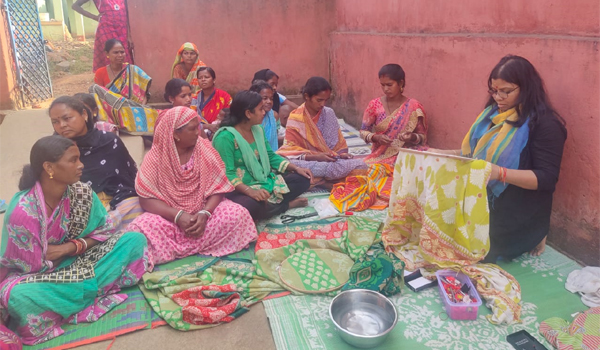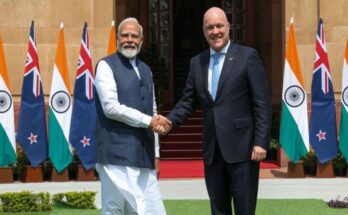samikhsya bureau
The fourth edition of the Barbil Art Project ‘Moving into the Margin’ began on the 6th of December 2019 with ten artists participating from various parts of India. This project aims at developing art works on site with an objective to establish a dialogue between the place, the people and the material. Arya Colony, Barbil with its extended site of schools around, village and iron palette making factory were chosen for direct intervention by the artists in a more inclusive manner. In the week-long project, the artists were initially introduced to the working environment and were allowed to choose their subjects based on the broad theme of margin.
Umesh Kumar, an artist from Bihar developed a structural model to recall environmental past wherein the people were constructing manual structures to meet their daily needs, a small bridge over river body, for example. This structure aims at making a library on the top of the unit that can be accessed by anybody who reaches the top. And to reach one has to take the bamboo ridden path, thereby creating a sense of past and touch, taking one back in the timeline, to enable a unique experience. Umesh explores his idea of nature with farmers and nature and so is Sitikanta Samantsinghar. His work dealt with a symbolic plough being prepared inhouse with wheat grains being allowed to germinate in process. The Arya iron palette factory operates with an aim to recycle almost every material that is used in its plant thereby ensuring zero waste and pollution, which seems to have inspired the artist to take up a subject that can go back to nature. The other work Sitikanta worked was to use the scrap leftovers to make a flower vase of a monumental size.
Bibhu Patnaik seem to have experimented with pata chitra artists deriving the minimalism through elementary motifs like line and dots, removing the subject and religious approach to redefine abstraction. He also uses the scrap to make an installation of the similar kind of form made of iron plates. Trinath Mohanty, a trained printmaker prepared a portrait of a female labour from the iron plant with the help of play board, revealing through a print mould through mechanical etching that matches the person. The form has been deified through symbolic of iron ore that make a backdrop almost like a halo behind her head in a flower shape. Suresh Nair, another artist from Kerala dealt with the spiritual connection of thought at the entrance of the clubhouse on campus. Encircling the already existing lights, he has created a mirror as a fourth space that allows the visitors to be a part of the art. His endeavor engaged the children and people from the local community to try their hand at the rendering the motifs.
Ajay Sharma, a performative artist from Chandigarh engaged himself onsite at the factory using the scraps to create a cyanotype print and some drawings from the available material. His preparation of the art involved the support members from the plant made the work process more adventurous and exciting. Rajesh Kumar Singh is a documentary photographer was engaged in shooting the nuances of people and the place with details of two subjects; one, coding the walls of the factory area through the lens as well as recording the ‘foot’ of the workers as a metaphoric representation.
Three female artists were extremely expressive by engaging with the schools and village community around. Archana Das connected with the children to create prints by them and gifted them back with the printed bags as a souvenir and also created a book by the children recording their personal experiences along with the drawing impression that was printed with linocut for presentation. Ankita Kashyap addressed the issue of gender by underlining the gender discrimination, beginning with her personal experience from home outward. Her metaphoric representation of words like Woomen, Wemen surrounding the two hands by the play of negative and positive space rendering. The masculinity of MEN overpowers the WOO and WE in the words with a subtle alteration. Pranati Panda engaged with the women folk of the nearby village to create a narrative out of their old sarees reinforcing motifs onto them, carefully embroidered with needle and thread, which represents a life of its own as well as a conversion of motif reflecting her idea of identity.
One of the intentions of the project is to introduce traditional artists to the art making by the contemporary artists. Thus, three traditional collaborative artists …….. from Patachitra, palmleaf engraving and gobar kandhei making extended their support to the artists while making their own art.
The event was designed to create an understanding of the participating artists through their creative journey. Thus, every evening, two artists presented their body of work to the local audience and initiated an intimate dialogue between the community and the artist. The evening event was extended with a cultural evening, representing Odisha tradition of music and culture, Ravanachhaya puppet theatre as well as Ghodanacha.
The fourth edition of the Barbil Art Project was curated by Pradosh Mishra with the curatorial assistance by Shambhavi Singh. The project was supported by the Arya Group of Industries, Barbil as part of the corporate responsibility towards the community awareness with creative direction of Utsha Foundation, Bhubaneswar. The project completes on the 12th December with a valedictory function at Bhubaneswar on the 13th December, 2019.




